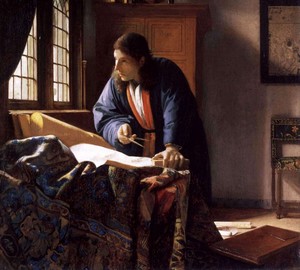
Description of the picture:
Geographer – Jan Vermeer. Canvas, oil. 53 x 46 cm
The 17th century is a period of seafarers, geographical discoveries, the formation of new sciences. Many artists in their work portrayed scientists. Jan Vermeer’s painting “Geographer” is also devoted to that active time.
At the same time, without a doubt, the author feels interest and understanding of this topic. See how carefully, accurately and in detail the globe, maps and cartographic tools are drawn – a pair of compasses and a square, designed to determine the angle of the planets.
Before us is a young man leaning over the papers, with a compass in his hand. His appearance is deeply thoughtful, and we can safely assume that the person is engaged in scientific research. The fact that he is a scientist, and is engaged in such a scientific field as geography, says the interior of the room and all this is reflected in the surrounding objects.
In the corner on the closet are books and a globe. Interestingly, after a careful study of the canvas, art critics determined that the globe was turned to the viewer by the Indian Ocean, in which the East India Company created by Dutch merchants was the leading trade monopolist at that time.
On the wall is a detailed geographic map. Moreover, researchers at Vermeer say that this is a map of Europe. On the floor are abandoned rolls with drawings.
The pouring light from the window illuminates the figure of the scientist. He is wearing an oriental-style bathrobe. At the time of Vermeer, such an exotic kind of clothing was adopted precisely by people of science. And, of course, the author could not do without his beloved blue color – he stands out both on the clothes of the man and on the patterns of the tablecloth.
The scientist’s gaze, narrowed and looking away, suggests a moment of the highest tension of thought, another moment and some solution will be found, or maybe there will be a discovery of something new, hitherto unknown to science.
The picture is not at all static, as the author uses the effect of a blurred image of the face of the main character to give dynamics to the plot. It seems that the artist captured exactly that moment when the scientist turns his face and gaze towards the window.
It is known that Jan Vermeer was rather reckless in identifying his paintings, often did not put his autograph and date of creation on them. But the work of “Geographer” is signed by the author, and not only in the most prominent place – on the wall, but also on the cabinet door. Why? Unknown Can especially careful execution and reverent attitude to science? As always, the great Vermeer left us a mystery."